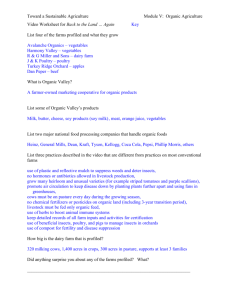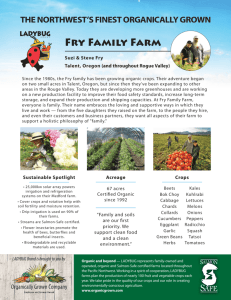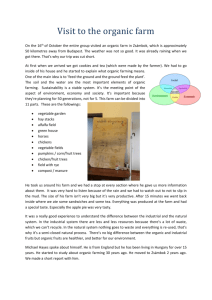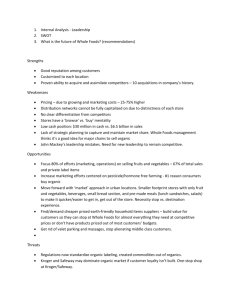OP PERATI ING A A PROF
advertisement
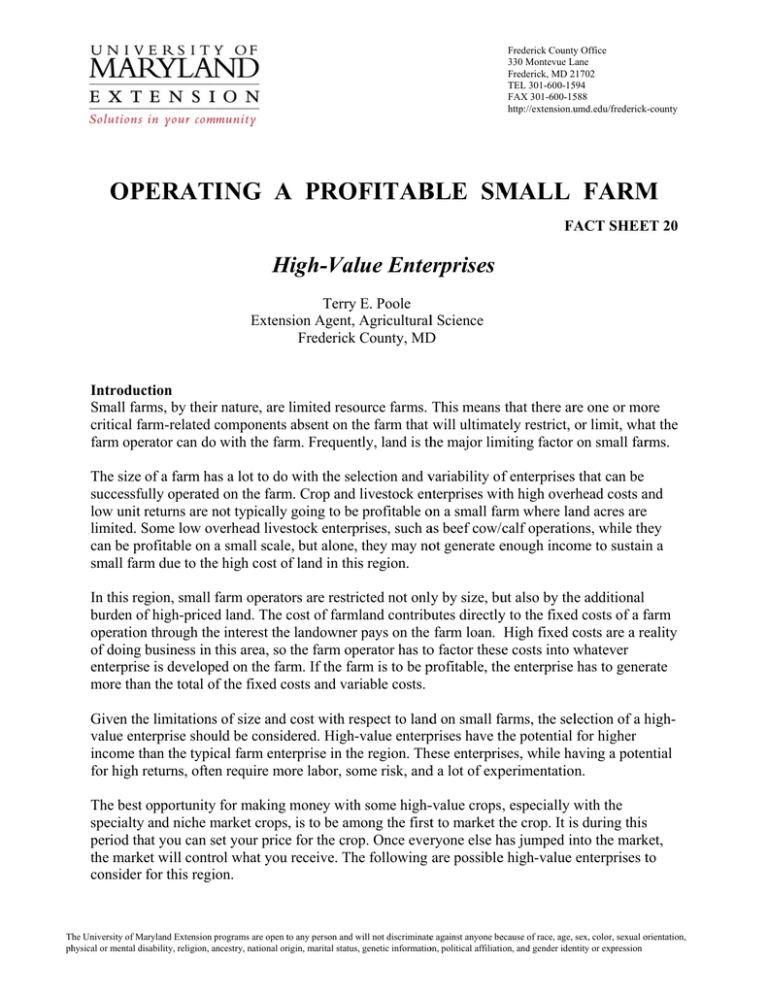
Frederick Countyy Office 330 Montevue L Lane Frederick, MD 221702 TEL 301-600-15594 FAX 301-600-15588 http://extension.uumd.edu/frederickk-county OP PERATIING A PROF FITAB BLE SM MALL FARM M FA ACT SHEE ET 20 High-Val H lue Enteerprises Terry E. Poole Extenssion Agent, Agriculturall Science Frederick County, MD D Introducction Small farrms, by theirr nature, are limited reso ource farms. This means that there arre one or moore critical faarm-related components c absent on th he farm that will ultimattely restrict, or limit, whaat the farm opeerator can do o with the farrm. Frequenttly, land is thhe major lim miting factor on small farrms. o with the sellection and vvariability off enterprisess that can be The size of a farm haas a lot to do ully operated d on the farm m. Crop and livestock ennterprises witth high overrhead costs aand successfu low unit returns are not n typically y going to be profitable oon a small faarm where laand acres aree limited. Some S low ov verhead livestock enterp prises, such aas beef cow/ccalf operatioons, while thhey can be prrofitable on a small scalee, but alone, they may noot generate eenough incom me to sustainn a small farm due to thee high cost of o land in thiss region. In this region, small farm f operato ors are restriicted not onlly by size, buut also by the additional burden of high-priced d land. The cost c of farmland contribbutes directlyy to the fixedd costs of a ffarm operation n through thee interest thee landowner pays on the farm loan. High fixed ccosts are a reeality of doing business in this t area, so the farm operator has too factor thesee costs into w whatever enterprise is developed on the farrm. If the farrm is to be pprofitable, thhe enterprise has to generrate more than the total of the fixed costs and varriable costs. farms, the sellection of a hhighGiven thee limitationss of size and cost with reespect to landd on small fa value entterprise shou uld be consid dered. High-value enterpprises have thhe potential for higher income th han the typiccal farm enteerprise in thee region. Thhese enterprisses, while haaving a potenntial for high returns, r often n require mo ore labor, some risk, andd a lot of expperimentation. The best opportunity y for making money with h some high--value crops, especially w with the y and niche market m cropss, is to be am mong the firstt to market tthe crop. It iss during thiss specialty period th hat you can set your pricee for the crop p. Once everryone else hhas jumped innto the markket, the market will contrrol what you u receive. The following are possiblee high-value enterprises tto consider for this region. Thhe University of Maryland Extension programs p are open to t any person and will w not discriminatee against anyone beecause of race, age, sex, color, sexual oorientation, phhysical or mental diisability, religion, ancestry, a national orrigin, marital status,, genetic informatioon, political affiliatiion, and gender idenntity or expression Artificially Dried Hay This region has a strong market for hay, since it has the highest population of livestock and horses in the state. While there is usually plenty of hay available at any given time of the year, there is usually a shortage of high-quality hay. Often there is a premium price paid for the very best hay. Unreliable weather conditions are often responsible for this lack of consistent quality. Developing a solar or gas fired system to dry hay would provide a sound way of minimizing the risks associated with making quality hay. The premium price benefits received from marketing a green, leafy hay product will more than offset added production costs. High-value hays such as alfalfa and timothy would be good choices for this system. Organic Feed Grains and Hay The rapidly growing organic foods market is beginning to see more producer interest in organic livestock operations. These prospective organic operations include dairy farms, goats, sheep and beef production. There is also interest in feeding organic feeds to horses by owners who are concerned about the quality and safety of current feed supplies. At present, there are few organic feed grains and forages available in this region. The lack of a consistent and reliable source of feed has kept many local producers away from the organic livestock market. Developing an organic feed enterprise will require some investment in capital and time because the farm has to be certified through the state’s organic certification program. The premium for organic feeds is typically an additional 30 percent. Organic and Small Animal Livestock The ongoing debate about the safety of the U.S. meat supply has helped to establish a market for organically grown meat animals. Premiums can be obtained on organically grown beef, sheep, poultry, rabbits, and other animals. The USDA is developing organic standards for certifying organic meat. The preliminary list of acceptable feedstuffs and supplements looks like this is a workable enterprise, however, obtaining consistent, reliable feed supplies will be a limiting factor in the beginning. The market potential for small animals appears very strong. Demand is currently high for free range poultry products, including eggs and meat. Free range chickens are produced on pastures, not in poultry houses. Other small animals with strong markets include meat goats and rabbits. Growing ethnic populations of the Baltimore/Washington area have increased demands for meat goats. Currently, very few meat goats are produced outside Texas. Meat rabbits are another good choice for small animal production. A market for these animals has already been developed in Western Maryland, where a rabbit processing facility packages several hundred rabbits each week. Organic Fruits and Vegetables There will always be a strong market for locally grown fruits and vegetables, and if they are organically grown, the “organic premium” price can be added to the product. The key is to either have a product that is not widely grown in the area, or to develop a marketing ploy to convince customers to choose your product over someone else’s. While the market for fruit is strong in this region, competition for the consumer’s fresh fruit dollars continually grows each year. 2 Heirloom and Unusual Vegetables There currently exists a strong market for vegetable varieties from the past. The taste for nostalgia promises to remain strong for now. In addition to the heirlooms, there is potential for niche marketing unusual vegetables. Uncommon vegetables like blue potatoes, white eggplants, and other odd-colored produce can be very profitable while they are in limited supply. Niche crops are most profitable in the beginning before everyone else starts growing them. Wine Grapes Wine grapes already have an existing market in this area due to the presence of several wineries and a chronic shortage of grape juice. Every year these wineries have to go outside of the area to purchase grapes to support their rapidly growing businesses. For this crop to pay dividends research the grape varieties preferred by the wineries and gather the patience to wait four years for a mature crop. Oriental Vegetables Oriental vegetables have excellent high-value crop potential. The market base exists in the growing ethnic populations of the Baltimore/Washington area. There is also good evidence that these healthful and tasty vegetables can be marketed successfully to non-ethnic consumers. There are a wide variety of oriental fruits and vegetables. Little is known about how they will grow in this region, so some experimentation is needed. Also, each distinct group within the Asian community has its own fruit and vegetable preferences, so some research needs to be done to determine which produce your customers will be likely to purchase. For descriptions of various oriental vegetables, read Fact Sheet 19 in this series, “Specialty Crops: Oriental Vegetables.” Herbs The production of culinary and medicinal herbs has excellent potential in this area. In addition to the potential for direct marketing fresh and dried herbs locally, there are several companies around the country where you can wholesale your medicinal herbs. Cut and Dried Flowers Locally produced flowers for the cut and dried flower market is very strong. There are several florists, direct markets and country stores around the area who would be interested in this product. Some homework should be done before jumping into large scale production. Begin by talking with potential customers and find out what flowers they want and when they want them. Select the ones that can be grown in this area. Start small there is no substitute for experience. Experimentation is always recommended on the small farm, but keep it small. Ornamental Trees and Shrubs The rapidly growing urbanization of this region has created a huge market for ornamental trees and shrubs. These true high-value crops require high investments in capital and time, however, they can be very profitable. This region has a long list of landscape companies and nurseries that annually need new stocks of quality plants. 3 Greenhouse The production of bedding plants and off-season vegetables has always had a good market, but the high startup and variable costs will scare some away from this enterprise. Greenhouses are expensive to build, and if the greenhouse is heated, costs can be significant. However the monetary rewards involved with greenhouse crops can also be significant. Greenhouses provide the ultimate in risk management, since the producer controls the environment. Tobacco Tobacco production is still big business in this state. Maryland does not have tobacco allotments, so anyone can grow it. Markets for this product are already established. Tobacco can be successfully grown here, since it was once abundantly grown in this region. Plans for small field drying racks are available. These racks can be used in place of a costly barn to cure the tobacco leaves. Tobacco can be a very profitable crop. Value Added Products Producers have some options available to them where commonly produced crops can be turned into high-value crops, through a process known as value added. Value added can be as simple as packaging a few ears of field corn and labeling it as squirrel food, or labeling some of your higher quality produce as gourmet and significantly increasing the price on these items. Processing produce into jellies, canned fruits and vegetables, breads, or any number of other potential products are some other options. There are some regulations involved with processed products, so check with the Health Department before you get too involved. Conclusion Be sure to do your homework before making a commitment to any of these high-value crops. Research the potential for a market a good producer has the commodity sold before it is planted. Also, find out what, how to, and how much to produce. Remember that high-value crops have the potential for high risk and/or loss. Be sure to develop business and marketing plans. Consider developing an irrigation system for the farm, because small farms are especially vulnerable to significant crop losses from drought. An effective irrigation system will significantly help with risk management on the farm. Diversity will also help to spread out risk. Many of the enterprises discussed in this publication can be produced as part of a farming operation that includes other enterprises. 4
